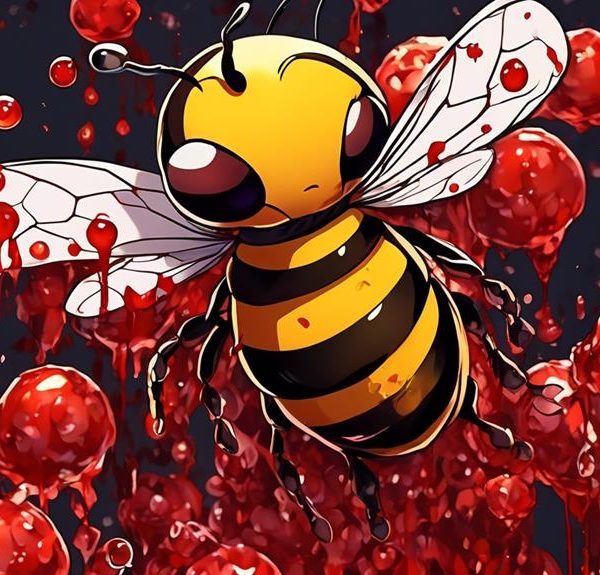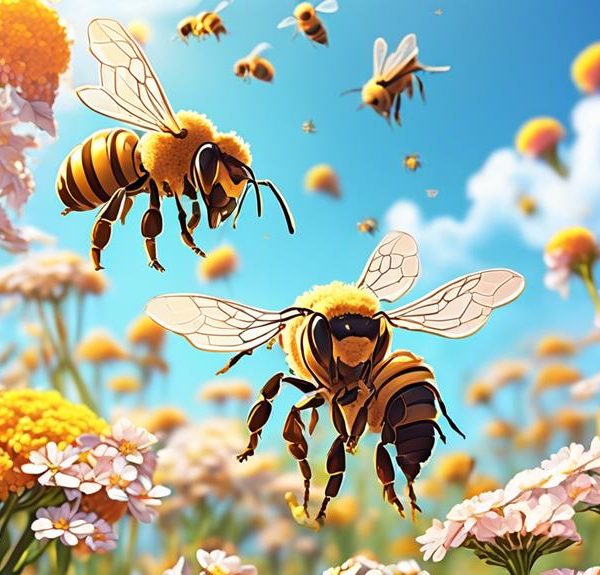Buzz into the world of bees and their love for Abelia, discovering the alluring factors behind this notable preference.
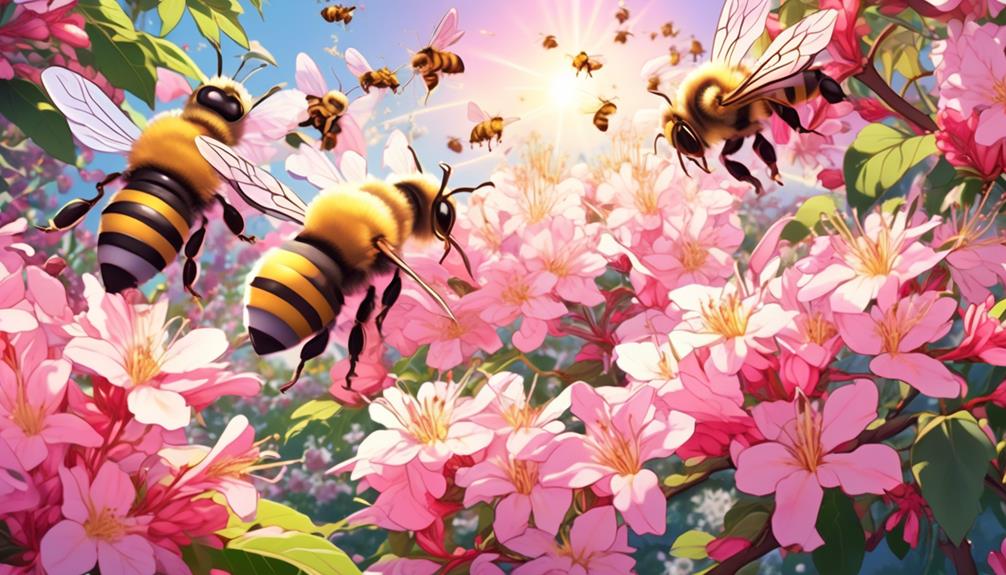
Do Bees Like Abelia?
Picture yourself in a tranquil garden, the sun casting a warm, golden glow on the vibrant Abelia shrubs scattered around. The air is filled with a subtle, sweet fragrance, and the gentle hum of bees busy at work.
You've likely observed that these bees seem particularly attracted to the Abelia plants, but have you ever wondered why? As a matter of fact, does this relationship go beyond mere coincidence, or do bees genuinely prefer Abelia?
The answer might not be as straightforward as you might think, as a multitude of factors influence this affinity. Stick around to learn more about the complexities of this fascinating interaction.
Key Takeaways
- Abelia plants are attractive to bees due to their nectar-rich blossoms and mild, sweet fragrance.
- The mutualistic interaction between bees and Abelia plants ensures the survival of both.
- Bees are attracted to flower colors in the blue, purple, and yellow range, and Abelia flowers fall within this preferred range.
- Enhancing Abelia's appeal for bees can be achieved through strategic planting, pruning, limited pesticide use, creating a bee-friendly environment, and providing a fresh water supply.
Understanding Abelia Plants
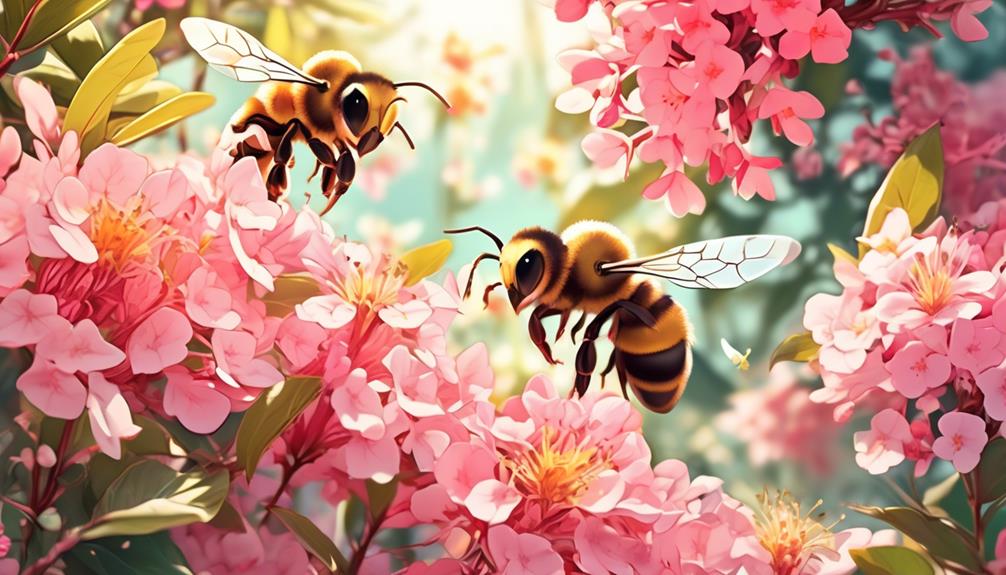
Diving into the world of Abelia plants, you'll find that they're a genus of about 30 species of flowering plants in the honeysuckle family, known for their attractive foliage and clusters of delicate, bell-shaped flowers. They're native to eastern Asia and southern North America, and they can thrive in full sun to part shade, providing you with a versatile gardening option.
When you're considering Abelia for your garden, you'll appreciate its low maintenance requirements. They're tolerant of various soil types, including sand, loam, and clay, as long as it's well-draining. They're also resistant to most pests and diseases, which means you won't have to worry much about their health and wellbeing.
One of the most striking features of Abelia is its long blooming season. From late spring to fall, Abelia rewards you with an explosion of color and fragrance, attracting a variety of pollinators. Specifically, they're known for attracting bees, which brings us back to our main question, 'Do bees like Abelia?' The answer is a resounding yes. They're not just aesthetically pleasing but also serve a crucial role in supporting your local ecosystem.
Importance of Bees in Ecosystem
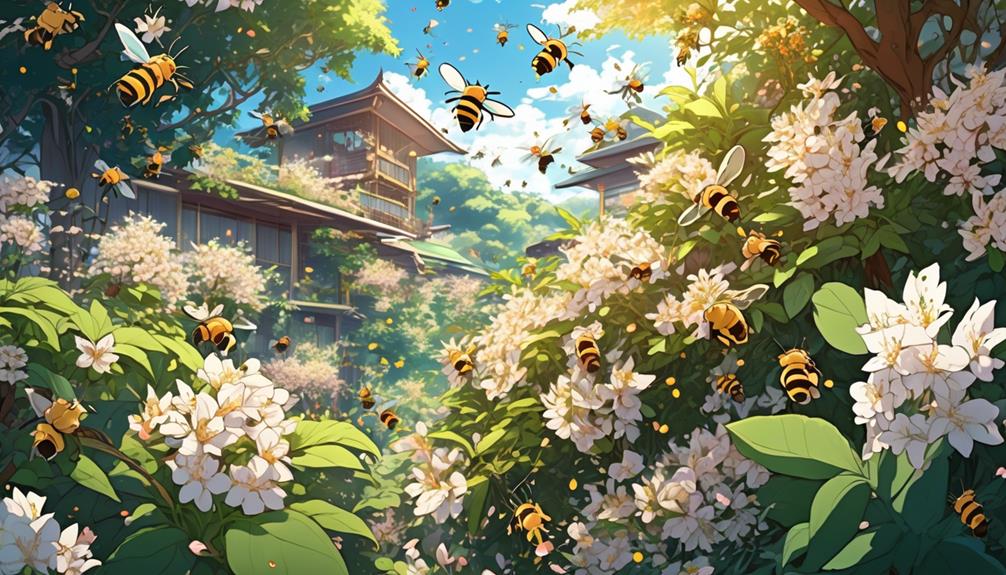
Understanding the importance of bees in our ecosystem, it's crucial to note that these hardworking insects play a pivotal role in pollination, contributing to the growth and propagation of various plant species including Abelia. They transfer pollen from the male parts of a flower to the female parts, enabling fertilization and the production of seeds.
Without bees, our diets would be vastly limited, as about one-third of the food we consume relies on pollination mainly by bees. They're especially vital for pollinating fruits and vegetables, thus significantly contributing to food security worldwide.
Moreover, bees help to pollinate plants that create habitats for other wildlife, forming a biodiversity web. They're indeed the linchpins of the ecosystem, their decline could disrupt the balance of nature, leading to the loss of biodiversity.
Sadly, bee populations are facing severe threats from pesticides, habitat loss, and climate change. Therefore, it's essential to safeguard their habitats, reduce the use of harmful pesticides, and plant more bee-friendly plants like Abelia.
In a nutshell, bees aren't just useful for honey production; their importance in maintaining the ecosystem's balance is immense. So, let's do our part to protect them.
The Attraction Between Bees and Abelia
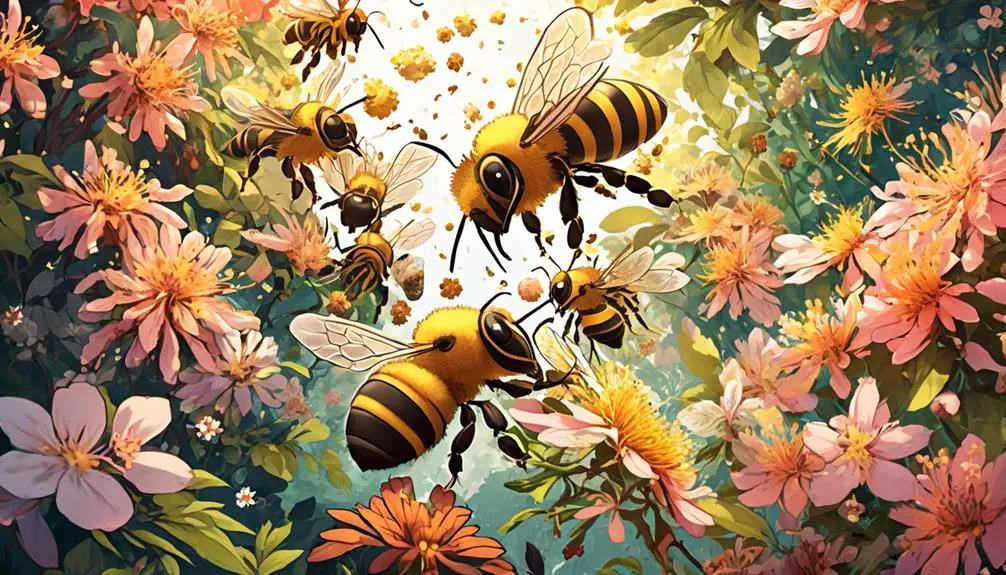
In light of the crucial role bees play in our ecosystem, it's particularly fascinating to examine their affinity for the Abelia plant, a relationship that not only benefits the bees but also contributes to the plant's propagation.
Abelia plants, with their bushy growth and profusion of small, tubular flowers, are proverbial magnets for bees. Their nectar-rich blossoms, emitting a mild, sweet fragrance, serve as an irresistible draw for these industrious insects, enticing them to pay frequent visits. The blossoms' bright colors, ranging from pink to white, further act as visual lures for bees.
But it's not a one-sided love affair. As bees flit from one Abelia flower to another, they inadvertently carry pollen on their bodies, facilitating the plant's cross-pollination process. This mutualistic interaction ensures the bees' survival by providing them with a reliable food source, while simultaneously aiding the plant's reproduction and genetic diversity.
Factors Influencing Bees' Preference
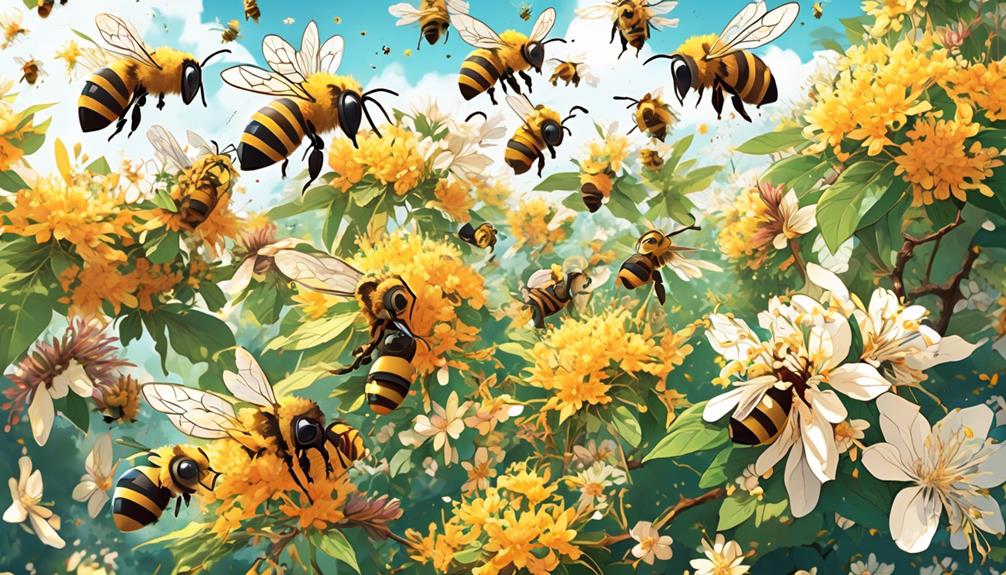
Several factors can sway a bee's choice of flowers, and understanding these can help explain their particular fondness for Abelia. These factors include flower color, scent, shape, and nectar production.
Firstly, bees perceive color differently from humans. They're drawn to flowers in the blue, purple, and yellow range, while red appears as gray. Interestingly, Abelias produce a myriad of small flowers that are often pinkish-white—a color close to the bees' preferred spectrum.
Secondly, the scent of a flower is a significant attractant. Abelias possess a mild, sweet fragrance that bees find appealing. The shape of the flower also plays a role. Abelias' tubular flowers provide an ideal platform for bees to land and forage.
Lastly, bees need nectar, a mixture of sugars, for energy. Abelias are generous nectar producers, making them a prime food source for bees.
In a nutshell, Abelias fulfill several key criteria that bees look for in flowers. Understanding this intricate interplay not only offers insights into the bees' preference for Abelias but may also guide our gardening choices to support these vital pollinators.
Enhancing Abelia Appeal for Bees
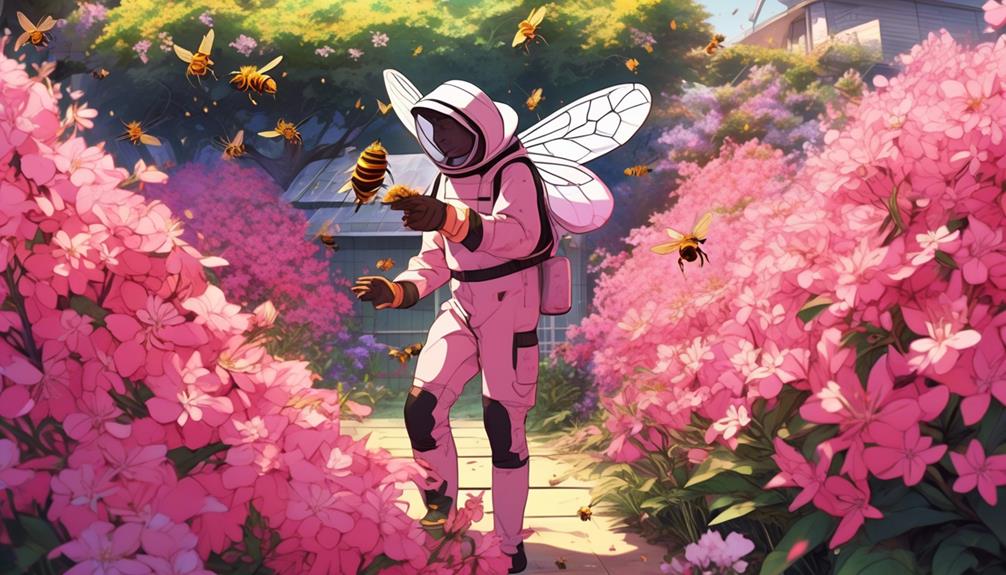
Now that we've explored why bees are attracted to Abelias, let's discuss how we can enhance the appeal of these plants for our buzzing friends. There are three key ways to do this: through strategic planting, proper maintenance, and creating a bee-friendly environment.
Strategic planting involves choosing the right location. Bees prefer sunny areas with some wind protection. Abelia's nectar production increases in full sun, making it more appealing to bees.
Proper maintenance is also critical. Regular pruning encourages Abelia to produce more blooms, which attract bees. However, avoid heavy use of pesticides, as they can deter or harm bees.
Creating a bee-friendly environment means providing a variety of plants for continuous blooming. Bees are more likely to visit your Abelia if other flowers are nearby.
For a quick reference, consider the table below:
Strategy | Description | Why it Works |
|---|---|---|
Strategic Planting | Choosing sunny, wind-protected spots | Increases nectar production |
Proper Maintenance | Regular pruning, limited pesticide use | Promotes blooming, protects bees |
Bee-friendly Environment | Variety of plants for continuous blooming | Keeps bees in your garden longer |
Practical Tips for Bee-Friendly Gardening
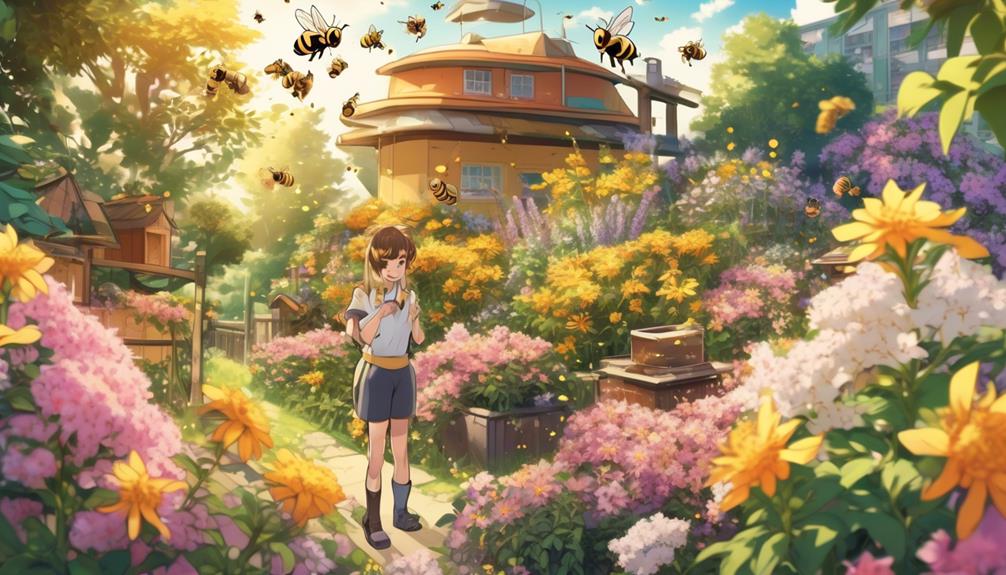
Before diving into the specifics, it's essential to remember that fostering a bee-friendly garden isn't just about the plants you choose; it's also about how you manage your garden's ecosystem.
Don't eliminate all the weeds; some, like dandelions, provide bees with early spring food. Avoid using pesticides, which can harm bees and other beneficial insects. Instead, opt for organic pest control methods.
Planting a variety of flowers that bloom at different times throughout the year ensures a continuous food supply for bees. Choose single-flower tops, such as daisies or marigolds, they're easier for bees to extract nectar.
When selecting plants, consider native species. These are often more attractive to local bees and require less maintenance. Bees also need water, so ensure a fresh supply is available. A shallow bird bath with stones for landing spots is perfect.
Frequently Asked Questions
What Other Insects Are Attracted to Abelia Plants Besides Bees?
Yes, besides bees, other insects are also drawn to Abelia. Butterflies and hummingbirds can't resist its fragrant, nectar-rich flowers. Even beneficial insects like ladybugs and lacewings are attracted to it.
But watch out! Aphids, scale insects, and mealybugs might also show up, which aren't so welcome. So, while you're enjoying the diverse insect life around your Abelia, keep an eye out for those pests.
How Can Bees Impact the Growth and Health of Abelia Plants?
You're wondering how bees can impact the growth and health of abelia plants.
Well, bees play a substantial role in pollinating abelia flowers. As they feed on the nectar, they transfer pollen from male to female parts, aiding in fertilization.
This process can lead to more robust plant growth and blooming. Without bees, your abelia mightn't thrive as well.
Are There Certain Types of Bees That Are More Attracted to Abelia Than Others?
Yes, there are certain types of bees more attracted to Abelia than others. Honey bees and bumblebees, in particular, are drawn to Abelia's nectar-rich blossoms. These bees favor its long blooming period, from late spring to early fall, providing them a consistent food source.
They're also enticed by the plant's tube-shaped flowers, which are perfectly structured for their feeding habits.
How Does Climate Change Affect the Relationship Between Bees and Abelia?
Climate change can significantly impact the relationship between bees and plants, including abelia. Rising temperatures can shift blooming times, throwing off the bees' foraging schedule.
Additionally, extreme weather conditions could lead to habitat loss. You'll see fewer bees, and thus, less pollination.
It's a complex issue that intertwines the survival of bees and the prosperity of plants like abelia.
Are There Any Potential Risks or Downsides to Attracting Bees to Your Garden With Abelia?
Sure, there can be downsides to attracting bees to your garden with abelia.
While bees are vital for pollination, they can also pose risks. If you, family members, or pets are allergic to bee stings, inviting bees can be dangerous. Additionally, bees can become aggressive when disturbed.
So, it's crucial to place abelia plants away from high-traffic areas.
But don't forget, a garden with bees is a healthy garden.
Conclusion
You've learned that bees love Abelia, drawn to its abundant nectar and extended blooming period. Factors like the plant's color, fragrance, and flower shape influence this preference.
Remember, enhancing your Abelia's appeal can boost your garden's bee population, benefiting our ecosystem.
So, let's keep planting Abelia and make our gardens bee-friendly. After all, every little step helps in preserving these vital pollinators.

